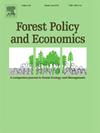影响林地所有者激励计划承诺期限选择的因素
IF 3.8
2区 农林科学
Q1 ECONOMICS
引用次数: 0
摘要
国家优惠森林财产税计划(PFPTP)通常用于激励土地所有者将其土地保持在森林状态。对于那些提供多个注册期的pfptp,土地所有者面临的一个重要决定是他们将土地投入该计划的时间长度,特别是如果该计划的经济效益与注册时间的长短有关。本研究探讨了影响森林土地所有者在选择参与提供多种承诺期限和相关经济利益的PFPTP时所做的计划期限承诺决策的因素。为了做到这一点,它使用了明尼苏达州可持续森林激励法案(SFIA)的注册数据。SFIA是一个国家fptp,每年向注册者提供补偿,以换取他们同意不开发他们的土地。它为注册者提供了多个项目承诺期限的选择,每个项目都有不同的年付款。我们开发了一个理论模型,说明考虑到注册期间无法出售林地用于开发的机会成本,利润最大化的森林土地所有者将如何在几个可用的承诺长度选项中做出选择。该模型在2002年至2021年期间使用超过1100个独特的SFIA注册进行了测试,结果发现SFIA注册者选择的课程承诺长度并不是由他们希望最大限度地提高注册的经济利益所驱动的。然后开发了第二个模型来评估所有者和林地特征如何与SFIA承诺长度的选择相关,发现几个属性与他们的承诺长度决策显着相关。本文章由计算机程序翻译,如有差异,请以英文原文为准。
Factors influencing a forest landowner's choice of incentive program commitment length
State preferential forest property tax programs (PFPTP) are commonly used to incentivize landowners to keep their land in a forested condition. For those PFPTPs that offer multiple enrollment periods, an important decision landowners face is the length of time they commit their land to the program, especially if the program's financial benefits are linked to the length of time enrolled. This study explores what factors influence the program length commitment decisions forest landowners make when choosing to participate in a PFPTP that offers multiple commitment lengths and associated financial benefits. To do so, it used enrollment data from Minnesota's Sustainable Forest Incentives Act (SFIA). The SFIA is a state PFPTP that provides annual compensation to enrollees in return for agreeing not to develop their land. It offers enrollees the choice of multiple program commitment lengths, each with a different annual payment. We developed a theoretical model of how a profit-maximizing forest landowner would choose one of several commitment length options available, given their opportunity cost of not being able to sell their forest land for development while enrolled. This model was tested using over 1100 unique SFIA enrollments from 2002 to 2021, which found the program commitment length SFIA enrollees select is not driven by their desire to maximize the financial benefit of enrolling. A second model was then developed to evaluate how owner and forest land characteristics are associated with the choice of SFIA commitment length, finding several attributes are significantly associated with their commitment length decision.
求助全文
通过发布文献求助,成功后即可免费获取论文全文。
去求助
来源期刊

Forest Policy and Economics
农林科学-林学
CiteScore
9.00
自引率
7.50%
发文量
148
审稿时长
21.9 weeks
期刊介绍:
Forest Policy and Economics is a leading scientific journal that publishes peer-reviewed policy and economics research relating to forests, forested landscapes, forest-related industries, and other forest-relevant land uses. It also welcomes contributions from other social sciences and humanities perspectives that make clear theoretical, conceptual and methodological contributions to the existing state-of-the-art literature on forests and related land use systems. These disciplines include, but are not limited to, sociology, anthropology, human geography, history, jurisprudence, planning, development studies, and psychology research on forests. Forest Policy and Economics is global in scope and publishes multiple article types of high scientific standard. Acceptance for publication is subject to a double-blind peer-review process.
 求助内容:
求助内容: 应助结果提醒方式:
应助结果提醒方式:


